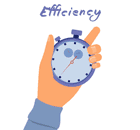How to Know Which Scrum Estimation Technique is Best for You
There are multiple Scrum estimation techniques, each having its own advantages and disadvantages. Therefore, let's explore some tips on how to choose the best Scrum Estimation technique.

Scrum is a popular Agile methodology that breaks large projects into manageable chunks (sprints) for quality deliveries and timely feedback. In Scrum-based project development, estimation is a crucial stage that helps to evaluate the backlog items, know the efforts, and set realistic expectations for stakeholders. Owing to that, there are many Scrum estimation techniques that can facilitate teams in the estimation process. So, picking the best one out of them isn't easy. Therefore, this article intends to cover the popular Scrum estimation techniques and then provide tips on how to choose the best Scrum Estimation technique for your team.
6 Popular Scrum Estimation Techniques
Before we dive deep into how to choose the best Scrum estimation technique, it is important to know about all the popular Scrum estimation techniques. So, below is the overview of the six popular Scrum estimation techniques:
1. Planning Poker
Planning Poker is a consensus-based and the most widely used Scrum estimation technique. In this technique, the Scrum team estimates the effort by assigning story points to user stories (backlog items) using the Modified Fibonacci sequence (0, 1, 2, 3, 5, 8, 13, and so on). The Product Owner narrates the user story, the development team discusses the story, and then each member provides an individual estimate by picking one of the poker-styled cards. Afterward, the team re-discusses or re-estimates (if required) to finalize the team's estimate. The process continues in the loop until all user stories are estimated.
Planning Poker offers accurate estimates when done rightly, as it involves comprehensive discussion, every member's individual estimates, and consensus-based decisions. It is believed to offer the best results for small and mid-sized Scrum teams looking to estimate complex projects.
2. Async Poker
Async Poker, or Asynchronous Planning Poker, is a modified version of Planning Poker that facilitates remote Scrum teams. In this technique, the Scrum team doesn't participate physically but gets the user stories in written form and the deadline by when they have to deliver their estimates. So, the team members estimate user stories on their own and deliver them to the moderator before the deadline. The moderator then collects all estimates from all members and finalizes the team's estimates.
Async Poker is best suited when the Scrum team involves remote members. Moreover, it also facilitates busy teams where members don't have time to spend hours in the estimation session. So, those teams who want to use Planning Poker but struggle to have on-premises estimation can use Async Poker to estimate.
3. T-Shirt Sizing
T-Shirt Sizing is another popular Scrum estimation technique and a lot similar to Planning Poker. In this technique, the Scrum team uses t-shirt sizes (XS, S, M, L, XL, and XXL) to estimate the effort instead of a numeric sequence in the case of Planning Poker. The Product Owner narrates the user story, the development team discusses the story, and then each member provides an individual estimate by picking one of the t-shirt size labeled cards. Afterward, the team might re-discuss or re-estimate (if required) to finalize the team's estimate. The process continues in the loop until all user stories are estimated.
Although the T-Shirt Sizing estimation technique is similar to Planning Poker, it does not guarantee accurate estimates due to a lack of numeric scale. However, it seems to suit small to mid-sized teams who want to easily estimate the efforts during the early stage of the project with minimal information.
4. The Bucket System
The Bucket System is a quick estimation technique popular in scenarios with a large product backlog to estimate. In this technique, the Scrum team places buckets, mostly numbered sticky notes, on the table or the wall in sequential order. The numbering of the buckets mostly ranges from 0-200, like 0, 1, 2, 3, 4, 5, 8, 13, 20, 30, 50, 100, and 200. The user stories are written on cards or pieces of paper. The team reads the stories and places them below one of the buckets. In the beginning, the team can collaboratively estimate a few stories to set a reference structure. Afterward, the Product Owner can divide the remaining user stories among all members and let them place user stories in appropriate buckets.
The Bucket System is a handy and fast estimation technique for quickly estimating a large number of user stories in a matter of a few minutes. It best suits new or busy Scrum teams who want to quickly estimate product backlogs. However, it lacks discussion rounds and collaborative estimation of user stories, which are essential for estimation accuracy.
5. Dot Voting
Dot Voting is the easiest and simplest Scrum estimation technique. In this technique, the Scrum team uses dots to reflect which user story requires the most effort. The Product Owner writes the user stories on cards or sticky notes and places them on the wall or the table. Afterward, the development team members put dots on the user stories they believe require the most effort. After voting, the Product Owner re-arranges the user stories based on higher to lower effort levels.
Dot Voting is a straightforward way of estimating in Scrum and best suits new teams who want to get familiar with the estimation process. Besides that, large Scrum teams can also use this technique to value everyone's opinion in the estimation. Moreover, it also facilitates situations when there is a large product backlog to estimate, and the Scrum team wants to estimate it in minimal time.
6. Affinity Estimation
Affinity Estimation is another quick way of estimating a large number of user stories. In this technique, the Scrum team conducts relative sizing of user stories. To do that, the team first takes a few user stories and then moves them until every story is arranged based on their relative size, from smallest to largest. For example, if you have three user stories, X, Y, and Z, where X is the smallest, Z is the largest, and Y comes in the middle. You will first take the user story Y and place it in the middle. Afterward, you will take user story X, see if it's smaller or bigger than Y, and then place it on the left or right. Similarly, you will do this for user story Z. This is how the Affinity Estimation technique uses relative sizing to estimate product backlog.
Affinity estimation is suited for small teams who want to estimate a large product backlog quickly. However, it also lacks discussions around user stories, so the estimates are not that accurate compared to Planning Poker or Async Poker.
How to Choose the Right Scrum Estimation Technique
Looking at all the above six estimation techniques, it is clear that each technique offers different advantages and disadvantages. For example, Planning Poker offers accurate estimates but is unsuitable for large product backlogs. Alternatively, Dot Voting offers less accurate estimates but is suitable for large product backlogs. Therefore, finalizing one technique as the best Scrum Estimation technique is not easy.
The recommended approach is creating a checklist considering different factors and picking the technique that seems the perfect choice. To help you with it, below are some of the key factors to consider while choosing the right Scrum estimation technique:
1. Accuracy Level
Depending on your project, determine your target estimation accuracy level. For example, if you are working on a complex project, then it will require high precision and accurate estimates for proper planning. So, if you need accurate estimates, Planning Poker and Async Poker are recommended. For less accurate estimates, T-Shirt Sizing, Dot Voting, and others are useful.
2. Project Size
The project size is also important for picking the right Scrum estimation technique. For large projects, you need an estimation technique that can assist in fast estimates, such as Bucket System, Dot Voting, or Affinity Estimation. For small-sized projects, you can use Planning Poker, Async Poker, or the T-Shirt Sizing technique.
3. Project Complexity
Project complexity helps determine which estimation technique can provide the most optimal results. For complex projects, there is a need for more team collaboration and deep discussion to determine uncertainties and set up development strategies. Therefore, Planning Poker and T-Shirt Sizing are best for complex projects, as they encourage team discussion before estimating.
4. Team's Estimation Experience
The team's previous estimation experience helps determine whether it can use complex estimation techniques. For example, Planning Poker, Async Poker, and T-Shirt Sizing require a bit of previous estimation experience, while Dot Voting, Bucket System, and Affinity Estimation are easy to execute and more suitable for new Scrum teams.
5. Time Available for Estimation
The Scrum team members are often busy with other activities and don't have the time to spend hours in the estimation process. That's why it is important to finalize how much time the team is willing to spend and then choose the estimation technique accordingly. For example, if the team is willing to spend 2-4 hours in the estimation session, then Planning Poker or T-Shirt Sizing suits best for accurate estimates.
6. Team's Working Model
With the growing trend of hybrid work culture, there are many Scrum teams where members are working both remotely and on-premises. Therefore, you should pick the estimation technique that fits your working model. For example, if your team involves a few remotely working employees, then you can use Async Poker to estimate the product backlog remotely.
7. Team Preferences
It is also important to ask your team about which estimation approach they are most comfortable with. For example, some teams prefer a collaborative technique, such as Planning Poker or T-Shirt Sizing, while others require simple and quick techniques, like Async Poker, Dot Voting, etc.
8. Stakeholder Involvement
Stakeholders' interests can also influence the estimation technique choice. If stakeholders want to get more involved in the estimation process, then you have to pick an estimation technique that is more collaborative, such as Planning Poker or T-Shirt Sizing. If stakeholders just want to see the estimated backlog, then you can even choose a simple estimation technique, such as Dot Voting, Affinity Estimation, etc.
9. Formality Level
Some organizations have a strict policy of keeping everything formal in the project. If that's the case, then you have to choose a more formal estimation technique, such as Planning Poker, Async Poker, or Bucket System.
Wrapping Up
Estimation in Scrum helps teams better glimpse efforts and ensure quality and timely project deliveries. Therefore, finding the right Scrum estimation technique is crucial for the project's success. Above, we have discussed in detail the top Scrum estimation techniques and the factors to consider to find the right Scrum estimation technique for your team. Overall, it is clear that different teams use different estimation techniques depending on their project, team size, and other factors. So, there is no one technique as the favorite for all. Therefore, create a checklist considering the above factors and find the best technique for your team.




